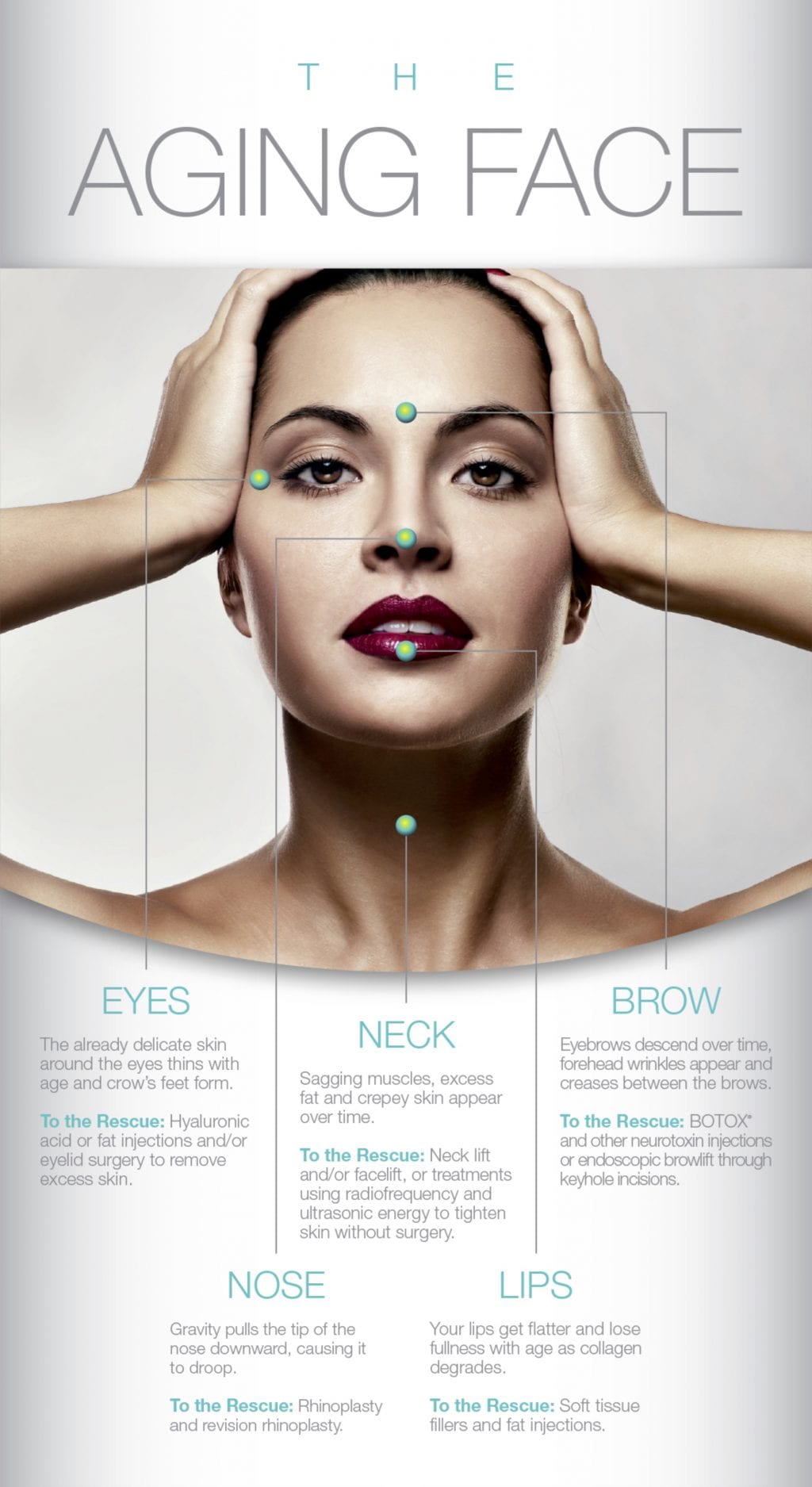Gravity or drooping is only one aspect of looking older. Shrinking, shriveling, thinning, frowning, and discoloring play a role too in appearing older. Each of this varying aspects of facial aging play a different role in everyone. One may look older due to droopy eyes, while another has a “tired” appearance from sunken cheeks. In addition, each area ages differently. Dark circles and lower eyelid bags tend to develop much earlier, as compared to a droopy nasal tip.
The above infographic on the aging face is from the American Academy of Facial Plastic and Reconstructive Surgery, board certified surgeons who specialize in plastic surgery of the face, head, and neck.
“Facial aging is a multi-dimensional process involving all tissues, skin, muscle, fat, and bone.” – Houtan Chaboki, M.D
Eyes and Brow
The upper eyes and brow droop with age. While men should generally have lower eyebrows, most women desire higher, more feminine brows. In addition, the brow becomes thinner with less hair for women, which can be treated with Latisse®. A brow lift can be performed with either plastic surgery or wrinkle relaxers (ie. Botox®, Dysport®, Xeomin®) to reshape the brow.
The upper eyelid also develops excess skin with age. Sometimes the upper eye area may appear hollow or sunken-in from fat loss. There isn’t a non-surgical option to lift the upper eyelid, so Washington DC patients should consider upper blepharoplasty for a rejuvenated appearance.
Fine lines and wrinkles may start developing around the eyes in both men and women in the 30’s from a combination of loss of skin collagen and fat. Chemical peel, laser skin rejuvenation, and wrinkle relaxers are all potential treatment to reduce these wrinkles.
Lastly, fat increases around the eye itself, but fat loss occurs below the eyelid in the cheeks. This change in fat volume in the lower eyelid contributes to eye bags and dark circles. Lower eyelid bags can be treated with blepharoplasty, facial fillers, and/or fat injections.
Neck
Other the eyes, the neck is the next most common area that shows the signs of age. The neck ages from a combination of factors. Excess fat develops under the chin, despite a healthy diet and regular exercise. The neck skin and muscle (i.e. platysma) loses tone and sags as we get older, which create jowls or “turkey neck”. The glands and lymph nodes of the neck also drop too, as ligaments stretch. All these factors contribute to submental fullness (i.e. double chin) that is more common in older individuals.
Non-surgical treatments for the neck are still behind plastic surgery. From liposuction, chin implant, or face lift, multiple treatment modalities are available to lift the neck with minimal downtime.
Nose
The nasal tip also droops with age. The entire facial skeleton loses bone with age, but especially in the cheeks, dental areas, and chin. As a result of loss of this underlying bone support, the nasal tip drops. The nasal cartilage itself doesn’t change much with age, but the ligaments around the nasal cartilages weaken also contributing to a droopy tip. The nose appears longer too. Lastly, nasal skin also gradually thickens with age to be less smooth.
Rhinoplasty is the primary method to lift the nasal tip. While primarily considering as a teenager or younger adult, even older patients can benefit from rhinoplasty.
Lips
The upper and lower lips thin with age from loss of tissue volume. In addition, the white part of the upper lip lengthens, which results in less of the red lip showing. The philtral columns become flatter and the natural curvature of the upper lip’s Cupids’ bow loses definition. Loss of facial skeleton bone and teeth also contribute to older appearing lips. Facial fillers and fat injections are the primary methods to treat aging lips.
A patient’s aged appearance may be around the eyes, while another may develop more wrinkles around thinning lips. Each plastic surgeon and dermatology office will perform an examination and recommend a variety of treatment options to refresh your appearance. The best cosmetic surgeons tailor procedures to each patient and don’t perform just one type of cosmetic procedure.
Share your thoughts below.


Leave a Reply